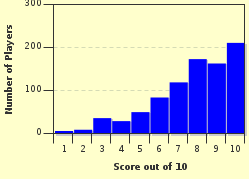Quiz Answer Key and Fun Facts
1. In order to be classified as an ace, you would need a certain number of "kills" or aircraft shot down. How many "kills" does it take to earn the title of "Ace?"
2. Which of the following squadrons would an American pilot have joined at the start of World War I?
3. Assume you were in the German Air Force. Your commander told you to go out to the flightline and take the triplane for a spin. Which of the following aircraft did the commander want you to fly?
4. If a plane's guns were not synchronized, the pilot could end up shooting off the propeller.
5. Going up and boring holes in the sky in a wire and fabric airplane is all good fun but when the Air Corps hired you, they kind of expected you to shoot other airplanes out of the sky and enemy ones at that. Which of the following would be the best position from which to attack an enemy fighter?
6. What was a Lufbery Circle?
7. Observation balloons were also targets. What kind of mission involved shooting down observation balloons?
8. If you wanted to be a flying ace this next bit of information would have been very important in your decision of which air service to join. Royal Flying Corps pilots who jumped out of their stricken planes had a terrible survival rate. Why was this?
9. Before a WWI flying ace blasted off into the sky in search of enemy planes it was important that he knew how to recognize an enemy plane. One way to do that could have been to fly alongside the enemy pilot and see what his uniform looked like. If it was different from yours, he might be the enemy. A better way could have been to fly alongside and engage the pilot in conversation. If he spoke the same language as the enemy he would have been someone you should attack. The best way, though, was to look for the national insignia on the sides and/or wings of the plane. If you were looking for a German plane, what insignia would be on the plane?
10. Manfred von Richthofen of Germany was the highest scoring ace of World War I with 80 victories. What was his nickname?
Source: Author
deputygary
This quiz was reviewed by FunTrivia editor
Exit10 before going online.
Any errors found in FunTrivia content are routinely corrected through our feedback system.

